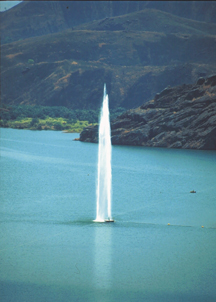 It sounds
like a bad horror movie: exploding killer lakes. But such lakes are a reality
in Cameroon, Africa. Scientists there are developing a solution, however, to
stop the natural hazard.
It sounds
like a bad horror movie: exploding killer lakes. But such lakes are a reality
in Cameroon, Africa. Scientists there are developing a solution, however, to
stop the natural hazard.In 1986, Lake Nyos in Cameroon exploded with a deadly cloud of carbon dioxide. Since then, researchers have been working to lower the carbon dioxide concentration in the lake by running an exhaust pipe 24 hours a day, expunging the lake of its extra gas, like the uncorking of a champagne bottle. Image courtesy of George Kling.
In 1984 and 1986, volcanic lakes Monoun and Nyos, respectively, silently erupted poisonous columns of carbon dioxide that swept out of their craters and into the valleys below — asphyxiating thousands of animals and 1,800 people along the way. “It came as a total surprise to everyone,” says Johan Varekamp, a geologist at Wesleyan University in Middletown, Conn. “Exploding lakes were a hazard we didn’t even know about,” he says. Since then, scientists have found only one other lake with similarly high concentrations of carbon dioxide and methane: Lake Kivu, also in Africa, may have similarly burst in the past several thousand years.
The carbon dioxide and methane in Monoun and Nyos, which have reached saturation levels of 97 percent, originate from magma deep beneath the lakes. The lakes are layered, with heavy carbon dioxide-laden waters at depth, topped by distinct layers of successively less concentrated waters. The climate in the area is not conducive for mixing, so the lakes stay layered unless something disturbs them, as happened in the 1980s (though scientists still do not know the exact cause of that disturbance).
The magma provides a continuous gas recharge into the lakes with no natural outlets, ensuring “a natural cycle of repeating disasters,” says George Kling, a geologist at the University of Michigan in Ann Arbor. It is not a question of if the lakes will erupt again, but when, he says. Thus, Kling and colleagues undertook a project to “degas” the lakes, in hopes of averting a future disaster.
In 2001, after years of theoretical modeling and with support from the Cameroonian government and international agencies, an international team installed a pipe in Lake Nyos to release some of the gas from the lake into the air. Big questions surrounded the experiment, Kling says: “If we brought up deep, heavy bottom water, would it sink right back down and cause enough destabilization in the stratified layers of water to cause another gas explosion?”
When the 50-meter fountain of gaseous water shot out of the pipe like a champagne bottle popping and Nyos did not immediately explode, the researchers continued to run the experiment. In 2003, they added a pipe to Lake Monoun. Continuous monitoring of the gas fountain and of the lake over the past several years supports that the pipes are not decreasing the stability of the lake, and that the degassing process is “actually working,” Kling says. Gas content in both lakes is already lower, and the carbon dioxide dissipates so quickly once it hits the air that there seems to be no local environmental ramifications, as Kling and colleagues reported in the Oct. 4 Proceedings of the National Academy of Sciences.
Still, Kling says, the current pumping rates in the lakes do little to actually remove the hazard quickly. In Monoun, the pumping rate and pipe depth are such that in two years, the pipe will be incapable of removing gas faster than it comes in. And in Nyos, the pipe removes so little gas that it will take decades to get the lakes to “safe levels,” he says. To significantly reduce the hazard in the area, Kling’s team recommends the installation of one more pipe in Monoun, which models indicate would remove 75 percent of the lake’s carbon dioxide. They also recommend four more pipes in Nyos, which would reduce the carbon dioxide levels by 99 percent by 2010.
People may always have some concern that stirring up the lake waters through more pumping might cause gas bursts, says Varekamp, who is not involved with the research. But, he says, the lakes will explode again unless people step in. “We can’t stop the San Andreas Fault from quaking, and we can’t stop a volcano from erupting, but here, in Cameroon, we have an engineered solution” that could avert the sure disaster of the lakes erupting again.

